Soles (and heels)
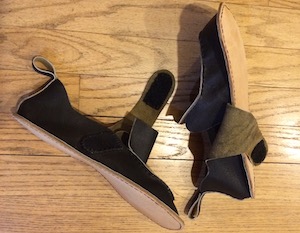
House shoes I made in 2016 and wore in winter for 7 years. Notice the very thin, flexible soles and the complete absence of any raised heel. These were wonderfully comfortable, and the only reason I stopped wearing them is that the velcro fastenings wore out, and I haven't replaced them yet.
The shoes, boots and sandals I make have no added heel at all. Neither do they have any toe spring (more on this below). The soles are as light and flexible as I can manage.
Basically, I aim to makes shoes that let my feet move as if I am walking barefoot. Inside the shoe:
- my heels are at the same height relative to the toes as they would be as if I were wearing no footwear at all (that is, they have zero drop from heel to toe);
- my foot can flex almost as well as it can when barefoot.
No heels are good heels
Any kind of raised heel height at all, anything greater than zero, can cause problems.
When we go barefoot as children, our heels are not elevated at all. We can stand or walk on tiptoe for very short periods, for example, when we reach for something from a high shelf. But this is typically so uncomfortable that we let our heels return to the floor as soon as possible.
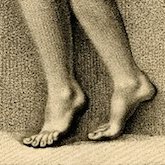
When you wear heels, your forefoot joints carry more weight than when your foot is flat on the floor.
Raised heels cause joint stress
Whether you stand on tip-toes or whether you wear footwear with a heel, your fore-foot takes more weight than when you wear no shoes at all.
I know from personal experience that any kind of raised heel increases the stress on the joint between the big toe and the main part of the foot. If the joint is already out of alignment because the big toe is being squashed towards the center-line of the foot, this adds insult to injury. Literally.
Raised heels cause bad posture
Humans evolved to have great posture. Watch a barefoot toddler, and you can see how the legs, hips and spine all work in alignment to support the head and torso, whether the child is walking, running or bending over to pick something up. Toddlers haven’t learned bad posture yet!
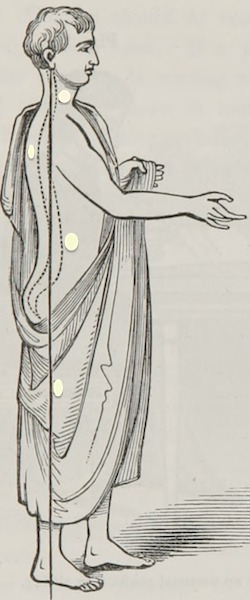
A barefoot gentleman with good posture, as shown by the vertical line connecting his ears (between which the top of his spine lies) with his ankles. Now imagine he had 2′′ heels: this line would no longer be perpendicular to the floor: he would go flat on his face unless he altered his stance.
If we have good posture, when we are standing still and upright on a level surface, an imaginary straight line can be drawn perpendicular to the ground, connecting our ears, shoulders, hips and ankles.
Raising our heels interferes with our posture. If our ears, shoulders and hips stayed in the same relationship with our ankles and toes as when we were barefoot, we would tip onto our faces. Something else needs to compensate so that the body can stay upright without tipping forwards.
Everyone compensates in their own way: whether by altering the position of hips/pelvis, ankles, or some other part of their body. I realized that I was unconsciously coping with raised heels by pushing my pelvis forwards slightly. This made my lower back over-arch. No wonder I was getting lower back pain!
Raised heels cause permanent deformation to the human body
If our feet are constantly in shoes with heels, over time, our bodies can literally deform. The tendons in the backs of the legs can shorten to such an extent that the heels stay elevated and unable to touch the ground even when the shoes are removed. Joints can start to wear and disintegrate. The arch can flatten and require support. And so on.
Doctors have been warning about such awful consequences for hundreds of years, yet almost all shoes one can buy have some kind of in-built heel.
Go zero drop: easier said than done
When I looked closely at my store-bought shoes, I found that every pair had some kind of elevated heel. Even sports shoes and slippers were raising the heel about 5 to 10mm above the toe.
The expectation of a heel is so ingrained in our western culture that to do otherwise looks odd unless perhaps it is a sandal or specialist sports shoe. Even men’s shoes typically have some kind of elevated heel built into the heel or the innersole.
Feet have flexible, uncushioned, zero-drop soles with no toe spring
Our bare feet have a tremendous ability to flex. We rely on this when undertaking any kind of locomotion. Walking, running, jumping, skipping and even swimming rely on the foot changing shape and position to propel us: forwards or backwards or sideways or up or down.
Stiff footwear soles constrain foot movement
Attaching the foot to an external sole starts to constrain the amount and direction of flex the foot itself can offer. The stiffer the footwear sole, the more constrained the foot in the degree and type of movement it can deliver.
Instead of using a wide variety of muscles, tendons and joints in the foot and ankle to propel the body (as we evolved over millenia to do), we are forced to make other parts of our body do more work to compensate.
We might also end up putting more force through particular parts of the foot, while our foot muscles and tendons atrophy and our joints wear unnaturally. Have you ever turned your ankle while hiking over rocks in stiff-soled shoes? What about straining your knees or hips?
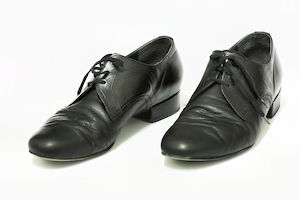
A pair of men’s formal shoes that were made on lasts. Notice how the ends of the toes are held well clear of the ground by the stiff leather soles, even though the considerable creasing of the uppers suggests that these shoes have been well worn.
Toe spring can be bad
Shoemakers have tried to compensate for the stiffness of footwear soles by designing footwear to have toe spring. That is, the ends of the toes are raised above the ground. Now you can rock forward on your stiff sole to propel yourself forwards.
But toe spring always holds the ends of your toes above the balls of your feet. High toe spring can cause tendon imbalances that can eventually result in crooked, deformed toes. Heels are already making the toes be unnaturally extended: toe spring can extend them even more.
There is debate about how much toe spring is too much. I tend to avoid it completely.
Even though I was able to order myself a pair of custom lasts that had no heels and a non-tapering toe shape, they still came with slight inbuilt toe spring: I had not thought to specify its absence, so it was included by default. It turns out that if I use these lasts to make footwear with sufficiently flexible soles, the inbuilt toe-spring largely disappears when the shoes are removed from the last. Needless to say, none of my lastless shoes have toe spring.
Cushioned soles vs bare feet
The human foot contains muscles and fat that provide some cushioning naturally. Plenty of people in cultures that don't wear shoes habitually can walk, run and jump for hours on hard surfaces without damaging their bare feet. For example, a pad of fat under the forefoot protects the metatarsal joints and the nerves leading to the toe. This fat pad can get displaced forwards by wearing shoes with pointy toes, raised heels, stiff soles and high toe spring. The nerves and bones become less padded, and a variety of symptoms can result, including nerve damage.
Shoemakers often add cushioning to soles, to make the footwear more comfortable (e.g. for people standing or exercising on hard surfaces) or to alleviate a particular kind of foot injury or condition, such as plantar fasciitis. But while they may offer short-term comfort, cushioned soles can (like stiff soles):
- reduce the amount of feedback we get from our feet about the nature of the surface we’re walking on
- lead to atrophying of muscles and tendons in the foot
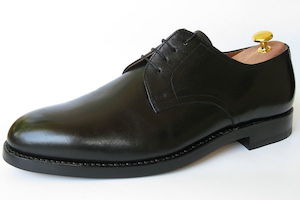
Even expensive men’s dress shoes have enough of a heel to cause issues with posture and joint stress. These soles also look stiff, thick and heavy.
As a result, people used to wearing cushioned shoes tend to have different gaits than people who rarely wear shoes. Gait affects joints, muscles and tendons in the knees, hips and back, not just the feet. Yikes.
In short, the more cushioning in our footwear, the worse it is likely to be for our bodies.
Soles and heels make shoes heavy
All footwear weighs something, even socks. Every gram of weight added to the foot is a gram that the body has to put extra effort into lifting during motion. Walking ten miles in heavy hiking boots puts stress on knees and other joints that would not be incurred when walking the same ten miles barefoot.
Much of a shoe or boot’s weight comes from its sole and heel: often the upper is relatively light (even if lined). Personally, I try to keep soles as light as possible (this also helps keep them more flexible). But there is a tradeoff between weight and durability: thick, heavy soles are less quick to wear out than thin, light soles.
The holy grail: hard to buy
It is getting easier to buy barefoot-style shoes, particularly sandals and running shoes, that have very thin, flexible soles with no heels or toe spring. However, many of these styles still have toe areas that are too tapered for me.
To get practical no-heel, no toe-spring shoes with flexible soles and enough toe room, I had to make them.